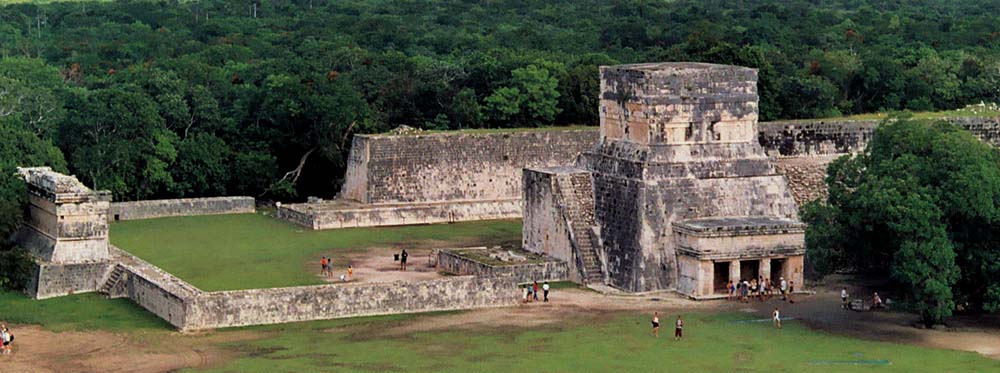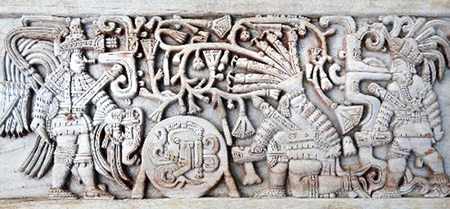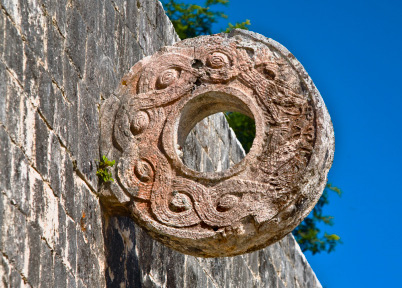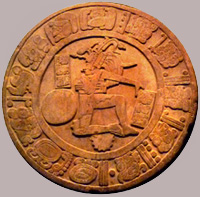THE BALL COURTS OF YUCATAN:
The great game of Creation.


Like many ancient spiritual cultures, the Olmec and the Maya erected stone monuments that echoed their interpretation of the universe. One of the many unique features to be found in Yucatan temple cities are the so-called ball courts where, according to orthodox view, warriors played a gruesome game with the severed heads of defeated enemies.
Nothing could be further from the truth.
There are more than eight ball courts at Chichen Itza, but the one in the northwest section is the most impressive. For one thing, it is laid out to a near 4:1 ratio, the equivalent to a double octave in music. It is acoustically tuned so that echoes rebound seven times off its lofty vertical walls. Repeating the musical connection, each wall features rings exactly 3×7 units above the ground, each carved with intertwined feathered serpents, the symbol of the regenerative force of nature.
Why anyone would go to the trouble of building an enclosure referencing musical notation for the purpose of a blood sport is beyond me. So let's continue.
Along the base of the high walls are panels of teams of ball players. In the Creation panel, a player has no head, and in its place rise seven wriggling snakes, each representing the central formative elements of light and sound (seven notes and seven visible colours); the sixth serpent carries the name Wak Chan, the Maya axis mundi or World Tree from which all sacred knowledge emanates.
This is the clue that begins to unlock the true purpose of the ball court. Another is the hieroglyph for the ball court: a stepped shape that resembles a crevice on the central mound of creation in Maya mythology. This crevice was called hom, and the word was regularly interchanged with 'ball court'.

Above: frieze along the ball court depicting the Creation Cycle.
A third lies in the creator god of maize, who himself lives in a complimentary ball court in the Otherworld. Like the Green Man who resurrects every winter solstice, his spirit enters the Middleworld through this crevice – much like the one built into the ball court above ground. Thus when players moved along the ball court they in effect interacted with a creative deity so as to learn the greatest game of all, the Game of Creation.
Another given name to the ball court was Tlach-tli ('the looking place') leading to the speculation that under certain conditions the area may have been used to depict the perpetual motion of the heavenly bodies, and from this, their link with human destiny, much like a spiritual astrological drama. This play was performed at night using obsidian mirrors.
By day it was used for the ball game itself, with players carrying obsidian mirrors on their backs, reminding the initiates that they must become mirror images of the perfection of the heavens if they are to lead exemplary lives.
The idea of the game was for a player to amass enough points to reach the centre of the field, which was called teocalli, 'home of the gods'. Certainly the walls depict a cylindrical Mercator projection of the planes around the zodiac, tracing a path of planets above and below the horizon, in effect depicting a figurative ball game of the gods.

One of two rings with intertwined serpents, the twin forces of masculine and feminine held in balance.
The flat court itself is a mirror of the numerical values of the adjacent pyramid of Chichen Itza, divided as it is into 99 squares, a number which coincides with the calibration of 8 lunar cycles with the solar calendar. The very same unit is found in the world’s largest stone circle, Avebury, and was used for the same purpose. The idea was to remind the player-initiate that the human body is the measure of the masculine Sun and feminine Moon. Some folk dances of Mexico are faint echoes of this celestial drama.
No wonder the ball court itself was seen as a figurative entrance into the Otherworld: the winner discovered the Mysteries of life, and by this connection with all levels of reality, he or she was thus enlightened. The Western expression for this ritual of initiation was 'raised from the dead'.
With its playing area divided into squares, the Olmec/Maya ball court may be a variation of the board game of chess, which originated in China. The unusual moves of each chess piece are designed to illustrate the laws of interaction between the invisible and causal worlds. They depict the motion of Creation itself. Some master players even learned to play chess blindfold to demonstrate their ability at connecting with a more intuitive level of reality. The connection with the ball courts of the Yucatan is that in 600 BC chess reached Persia, referenced in a romance called Karnamak-i-Artakshatr-i-Papakan, whose hero is noted for his abilities in ball-play.
It's not the first time a cross-cultural connection with Persian mysticism appears in the Americas: around Lake Titicaca, the carved portal of Amaru Meru has a counterpart in Anatolia, along with etymological roots, while at Tiwanaku, a bowl discovered in the silt features a cuneiform alphabet only found in Sumeria.
With the later degradation of civilization around the time of the arrival of Conquistadors, the original and spiritual meaning of the ball courts was already on the wane. One man's god became another's devil, and the unusual friezes depicting a strange and seemingly brutal sport were taken literally. But in truth the game was metaphorical, it was meant to teach initiates of the temple the greatest game of all: the game of life.
© 2015 Freddy Silva. Ball court photo by Andre Moller, Wikipedia Commons.
Return to Articles.

Ball court marker with astrological/calendrical notation.